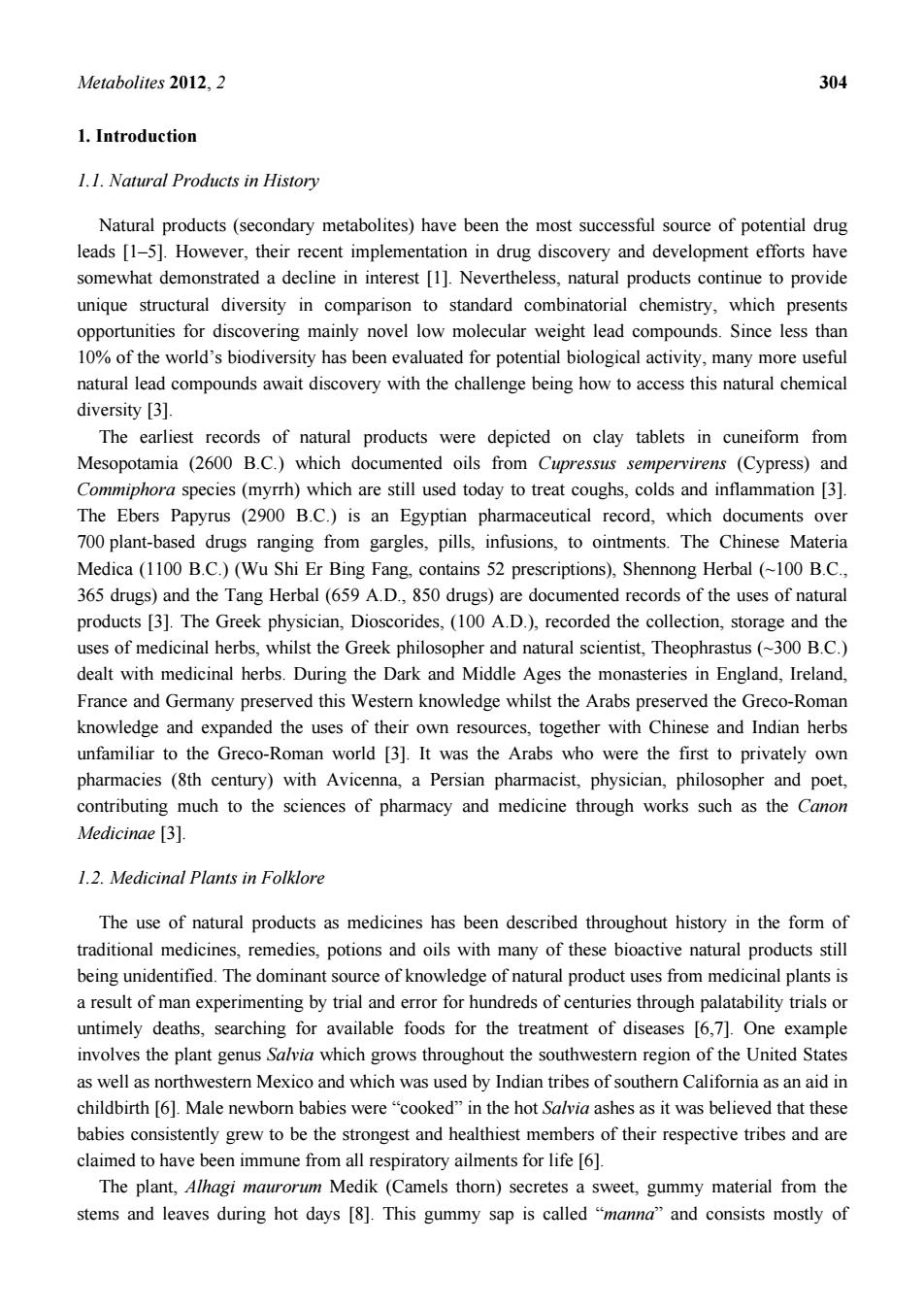正在加载图片...

Metabolites 2012.2 304 1.Introduction 1.1.Natural Products in History Natural products (secondary metabolites)have been the most successful source of potential drug leads [1-5].However,their recent implementation in drug discovery and development efforts have somewhat demonstrated a decline in interest [1].Nevertheless,natural products continue to provide unique structural diversity in comparison to standard combinatorial chemistry.which presents opportunities for discovering mainly novel low molecular weight lead compounds.Since less than 10%of the world's biodiversity has been evaluated for potential biological activity,many more useful natural lead compounds await discovery with the challenge being how to access this natural chemical diversity [3]. The earliest records of natural products were depicted on clay tablets in cuneiform from Mesopotamia (2600 B.C.)which documented oils from Cupressus sempervirens(Cypress)and Commiphora species(myrrh)which are still used today to treat coughs,colds and inflammation [3]. The Ebers Papyrus (2900 B.C.)is an Egyptian pharmaceutical record,which documents over 700 plant-based drugs ranging from gargles,pills,infusions,to ointments.The Chinese Materia Medica(1100 B.C.)(Wu Shi Er Bing Fang.contains 52 prescriptions),Shennong Herbal (-100 B.C.. 365 drugs)and the Tang Herbal (659 A.D.,850 drugs)are documented records of the uses of natural products [3].The Greek physician,Dioscorides,(100 A.D.),recorded the collection,storage and the uses of medicinal herbs,whilst the Greek philosopher and natural scientist,Theophrastus(300 B.C.) dealt with medicinal herbs.During the Dark and Middle Ages the monasteries in England,Ireland, France and Germany preserved this Western knowledge whilst the Arabs preserved the Greco-Roman knowledge and expanded the uses of their own resources,together with Chinese and Indian herbs unfamiliar to the Greco-Roman world [3].It was the Arabs who were the first to privately own pharmacies (8th century)with Avicenna,a Persian pharmacist,physician,philosopher and poet. contributing much to the sciences of pharmacy and medicine through works such as the Canon Medicinae [3]. 1.2.Medicinal Plants in Folklore The use of natural products as medicines has been described throughout history in the form of traditional medicines,remedies,potions and oils with many of these bioactive natural products still being unidentified.The dominant source of knowledge of natural product uses from medicinal plants is a result of man experimenting by trial and error for hundreds of centuries through palatability trials or untimely deaths,searching for available foods for the treatment of diseases [6,7].One example involves the plant genus Salvia which grows throughout the southwestern region of the United States as well as northwester Mexico and which was used by Indian tribes of souther California as an aid in childbirth [61.Male newborn babies werecooked"in the hot Salvia ashes as it was believed that these babies consistently grew to be the strongest and healthiest members of their respective tribes and are claimed to have been immune from all respiratory ailments for life [6]. The plant,Alhagi maurorum Medik (Camels thorn)secretes a sweet,gummy material from the stems and leaves during hot days []This gummy sap is called"consists mostly ofMetabolites 2012, 2 304 1. Introduction 1.1. Natural Products in History Natural products (secondary metabolites) have been the most successful source of potential drug leads [1–5]. However, their recent implementation in drug discovery and development efforts have somewhat demonstrated a decline in interest [1]. Nevertheless, natural products continue to provide unique structural diversity in comparison to standard combinatorial chemistry, which presents opportunities for discovering mainly novel low molecular weight lead compounds. Since less than 10% of the world’s biodiversity has been evaluated for potential biological activity, many more useful natural lead compounds await discovery with the challenge being how to access this natural chemical diversity [3]. The earliest records of natural products were depicted on clay tablets in cuneiform from Mesopotamia (2600 B.C.) which documented oils from Cupressus sempervirens (Cypress) and Commiphora species (myrrh) which are still used today to treat coughs, colds and inflammation [3]. The Ebers Papyrus (2900 B.C.) is an Egyptian pharmaceutical record, which documents over 700 plant-based drugs ranging from gargles, pills, infusions, to ointments. The Chinese Materia Medica (1100 B.C.) (Wu Shi Er Bing Fang, contains 52 prescriptions), Shennong Herbal (~100 B.C., 365 drugs) and the Tang Herbal (659 A.D., 850 drugs) are documented records of the uses of natural products [3]. The Greek physician, Dioscorides, (100 A.D.), recorded the collection, storage and the uses of medicinal herbs, whilst the Greek philosopher and natural scientist, Theophrastus (~300 B.C.) dealt with medicinal herbs. During the Dark and Middle Ages the monasteries in England, Ireland, France and Germany preserved this Western knowledge whilst the Arabs preserved the Greco-Roman knowledge and expanded the uses of their own resources, together with Chinese and Indian herbs unfamiliar to the Greco-Roman world [3]. It was the Arabs who were the first to privately own pharmacies (8th century) with Avicenna, a Persian pharmacist, physician, philosopher and poet, contributing much to the sciences of pharmacy and medicine through works such as the Canon Medicinae [3]. 1.2. Medicinal Plants in Folklore The use of natural products as medicines has been described throughout history in the form of traditional medicines, remedies, potions and oils with many of these bioactive natural products still being unidentified. The dominant source of knowledge of natural product uses from medicinal plants is a result of man experimenting by trial and error for hundreds of centuries through palatability trials or untimely deaths, searching for available foods for the treatment of diseases [6,7]. One example involves the plant genus Salvia which grows throughout the southwestern region of the United States as well as northwestern Mexico and which was used by Indian tribes of southern California as an aid in childbirth [6]. Male newborn babies were “cooked” in the hot Salvia ashes as it was believed that these babies consistently grew to be the strongest and healthiest members of their respective tribes and are claimed to have been immune from all respiratory ailments for life [6]. The plant, Alhagi maurorum Medik (Camels thorn) secretes a sweet, gummy material from the stems and leaves during hot days [8]. This gummy sap is called “manna” and consists mostly of